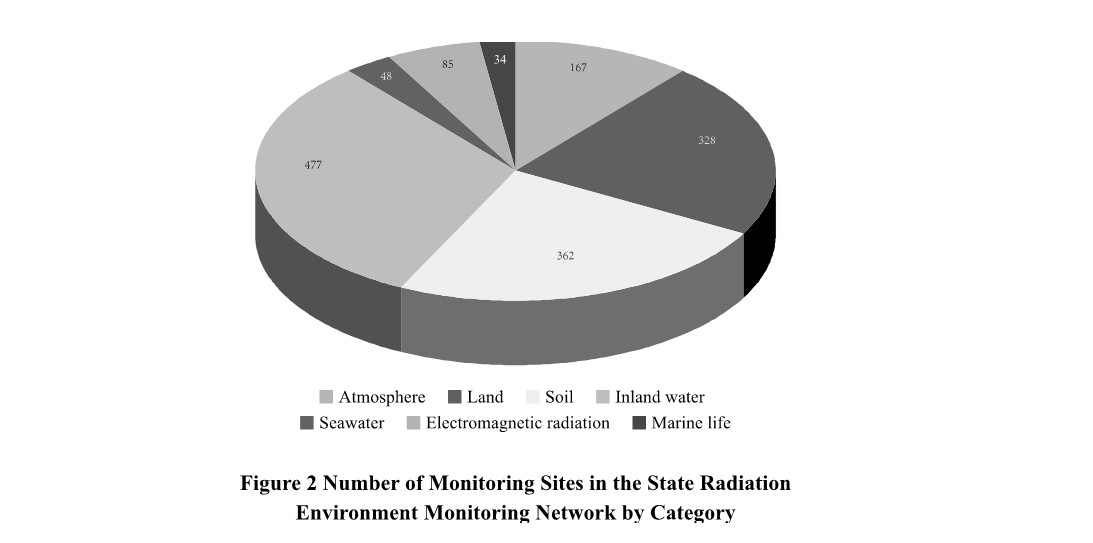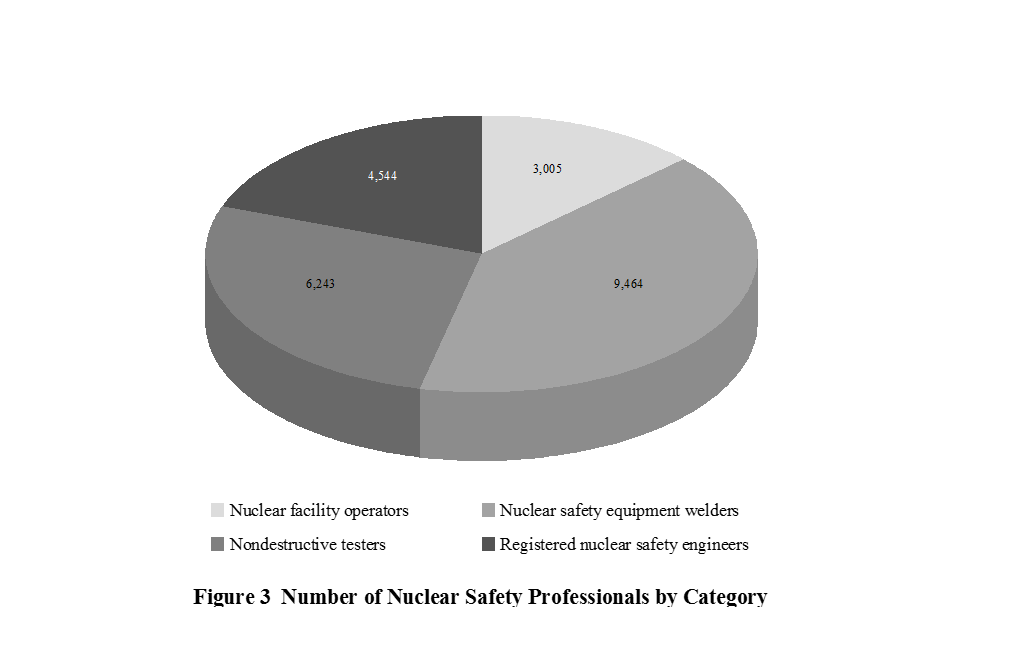Full text: Nuclear Safety in China
III. Ensuring Effective Regulation of Nuclear Safety
China treats nuclear safety as an important obligation of the state, and exercises unified regulation through special organizations and a regulatory system underpinned by independence, openness, the rule of law, rationality, and effectiveness. To ensure independent regulation of nuclear safety and enhance its authority and effectiveness, China has strengthened technical support and developed a professional team while modernizing the system and the regulatory capacity.
A three-pronged regulatory system. In China, unified regulation over the surveillance of nuclear safety, radiation safety, and the radiation environment is exercised independently, and a three-pronged regulatory system consisting of headquarters, regional offices and technical support organizations is in place. Established in 1984, the National Nuclear Safety Administration is responsible for the regulation of civil nuclear facilities, the formulation of nuclear safety policies, laws, regulations, standards, and plans, the implementation of nuclear safety license management, and the coordination of nuclear safety regulation across the country. To perform nuclear and radiation safety surveillance it has six regional offices in the north, east, south, southwest, northwest, and northeast of China. Professional technical support organizations such as the Nuclear and Radiation Safety Center and the Radiation Monitoring Technical Center provide technical support for nuclear safety review, independent verification, surveillance, law enforcement, and assessment of the radiation environment. Local governments at all levels regulate regional radiation safety through regulatory organizations or full-time/part-time regulators according to local conditions.
Comprehensive review and license management. The government has strengthened safety control of nuclear facilities, materials and activities and radioactive materials through comprehensive safety licensing and rigorous technical review. It exercises full life-cycle and phased license management over the siting, construction, operation, and decommissioning of nuclear power plants, research reactors, nuclear fuel cycle facilities, and facilities that handle the treatment, storage, and disposal of radioactive waste. The government implements license management over licensees that have nuclear materials, and over licensees that produce, sell and use radioisotope and radiation-emitting devices based on categories and levels of radiation. It performs approval and online monitoring over the transport of radioactive materials and implements license management over licensees that design, manufacture, install, and perform nondestructive testing of civil nuclear safety equipment, and licensees that design and manufacture containers for the transport of radioactive materials. A risk-informed and problem-oriented review system has been established, and efforts are being made to enhance the capacity of independent verification and calculations, probabilistic safety assessment, and risk assessment.
Whole-process surveillance and law enforcement. The government performs rigorous surveillance of nuclear facilities and units that are engaged in nuclear activities in accordance with the law, to ensure compliance with nuclear safety laws, regulations, standards, and licensing requirements. It carries out regular surveillance of units that operate nuclear facilities, manufacture nuclear safety equipment, and utilize nuclear technologies, covering all matters and activities in relation to nuclear safety such as design, purchasing, manufacturing, construction, operation, and decommissioning. The government performs on-site safety surveillance of key nuclear facilities and activities, urges enterprises in violation of relevant regulations to rectify, and punishes those that violate the law. It has initiated special programs to handle major cases caused by quality issues, taking resolute action against operations involving falsification and violation of regulations. A national platform has been set up for nuclear power plants and research reactors to share experience and information, to effectively ensure the safe operation of nuclear facilities.
Round-the-clock radiation environment monitoring. China has established a three-tier radiation environment monitoring system at state, provincial and municipal level, and three networks – national radiation environment monitoring, surveillance monitoring of radiation environment in the vicinity of key nuclear facilities, and nuclear and radiation emergency monitoring – to monitor radiation environment round-the-clock in all areas. As of June 2019, the state radiation environment monitoring network had 1,501 monitoring sites: 167 automatic monitoring sites for atmospheric radiation, 328 land sites, 362 soil sites, 477 inland water sites, 48 seawater sites, 85 electromagnetic radiation sites, and 34 marine life sites. There were also 46 radiation environment surveillance monitoring systems set up in the vicinity of key nuclear facilities as well as sites set up to monitor radioactivity in food.

Improved nuclear and radiation emergency response. China has set up the National Nuclear Accident Emergency Coordination Committee, and formed a three-tier emergency response system at state and provincial level and also at nuclear facility operating organizations, to organize emergency response to nuclear and radiation accidents. The state has established an emergency management system and a response and action mechanism for radiation accidents, and an emergency monitoring and dispatch platform that covers the whole country. All provinces and equivalent administrative units have carried out radiation response drills to enhance their capacity in rapid response and proper action to different types of radiation accidents. China has a 300-member national nuclear emergency rescue team and 25 professional rescue units, 8 types of national nuclear emergency technical support centers, 3 fast support bases for nuclear accidents at nuclear power plants, and 17 medical centers for treating nuclear radiation injuries. Regular joint nuclear emergency drills are carried out to improve preparedness and response.
Stronger professional teams. To meet the requirements of the development of the nuclear sector and nuclear safety regulation, China has given top priority to strengthening the professional teams, to develop an "iron army" with strong political convictions, professional capacity, impeccable conduct and a strong sense of responsibility. They will work under pressure, persevere, and dedicate themselves to the cause of nuclear safety. A nuclear and radiation safety regulation team has been formed, consisting of 100 persons at the headquarters, 1,000 persons at the central level, and nearly 10,000 persons nationwide. To cultivate leading figures in nuclear safety, the state has set up a national nuclear safety expert commission composed of 25 academicians of the Chinese Academy of Sciences and the Chinese Academy of Engineering, and more than 100 leading experts on nuclear safety. To develop the professional teams, China has enforced qualification management of nuclear safety professionals, strengthened the qualification management of nuclear facility operators, nuclear safety equipment welders, nondestructive testers, and other special posts, and required registered nuclear safety engineers for critical posts. China has established an education and training mechanism involving institutions of higher learning, research institutes, and enterprises, to expand the channels of professional training, strengthen the cultivation of nuclear safety professionals, and enhance their technical competence and safety awareness. As of June 2019, there were 72 universities in China running programs on nuclear engineering, of which 47 had separate schools on nuclear science, enrolling some 3,000 undergraduates in nuclear engineering each year.

Enhancing R&D in nuclear safety technology. China has included R&D in nuclear safety into national planning for scientific and technological programs, with a focus on work of a strategic nature for basic application and public good. China has established a National Research and Development Center for Nuclear and Radiation Safety Regulation, conducted research on key technologies of radiation environment monitoring and technical review, and employed new technology in review and surveillance. The state encourages the nuclear industry to develop and apply advanced and reliable nuclear safety technology. Important results have been achieved in the technological research and demonstration projects on advanced reactors and supporting systems. A proprietary distributed control system (DCS) for nuclear power plants has been applied in the Hualong-1 demonstration project. The pressurized water reactor CAP1400 has made important breakthroughs. Demonstration projects in high temperature gas-cooled and sodium-cooled fast reactors are making headway, and R&D in small reactors for different applications are progressing smoothly. China is using more nuclear power equipment manufactured domestically, and working hard to increase its manufacturing capacity in nuclear power equipment. It has made steady progress to independently produce key equipment of GW-class nuclear power units, achieving key successes in the independent R&D and manufacturing of pressure vessels, steam generators, main pipelines, advanced nuclear fuels, nuclear-grade welding materials, and other key nuclear safety equipment and materials.
Full implementation of nuclear safety improvements. In the wake of the Fukushima nuclear accident in Japan, the Chinese government organized a nine-month safety inspection of the country's operating nuclear power plants, those under construction, research reactors, and other key nuclear facilities. The result showed a minimal possibility of nuclear accidents, as the sites of China's nuclear facilities had been selected with full consideration of extreme natural disasters such as earthquake, flood, and tsunami. Learning from Japan's lesson, the Chinese government has further enhanced its nuclear facility safety by implementing improvement plans for the short, medium, and long terms and by increasing nuclear facilities' capacity to resist external events and prevent and mitigate serious accidents.